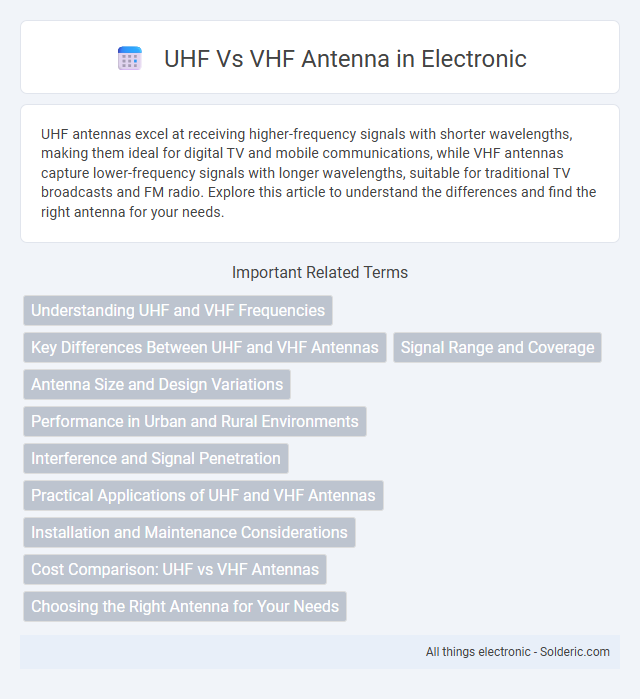UHF antennas excel at receiving higher-frequency signals with shorter wavelengths, making them ideal for digital TV and mobile communications, while VHF antennas capture lower-frequency signals with longer wavelengths, suitable for traditional TV broadcasts and FM radio. Explore this article to understand the differences and find the right antenna for your needs.
Comparison Table
| Feature | UHF Antenna | VHF Antenna |
|---|---|---|
| Frequency Range | 300 MHz to 3 GHz | 30 MHz to 300 MHz |
| Wavelength | 10 cm to 1 m | 1 m to 10 m |
| Signal Penetration | Better through buildings and obstacles | Less effective in urban environments |
| Range | Shorter, suitable for local area coverage | Longer, effective over large distances |
| Antenna Size | Smaller, compact design | Larger, requires more space |
| Common Uses | TV broadcasts, cellular, Wi-Fi, GPS | FM radio, TV broadcasts, marine communications |
| Interference | More prone to interference from physical objects | Less affected by obstacles but more by atmospheric noise |
Understanding UHF and VHF Frequencies
UHF (Ultra High Frequency) and VHF (Very High Frequency) antennas operate within distinct frequency ranges, with VHF covering 30 to 300 MHz and UHF spanning 300 MHz to 3 GHz. VHF frequencies have longer wavelengths, offering better range and penetration through buildings, making them suitable for rural and outdoor environments. Your choice between UHF and VHF antennas should consider the specific frequency band requirements of your communication devices and the surrounding environment for optimal signal reception.
Key Differences Between UHF and VHF Antennas
UHF antennas operate within the 300 MHz to 3 GHz frequency range, providing better performance for digital TV signals and urban environments due to their shorter wavelengths and smaller size. VHF antennas work in the 30 MHz to 300 MHz range, delivering longer transmission distances and superior penetration through obstacles like buildings and terrain. Understanding these key differences helps you choose the right antenna for optimal signal reception based on your location and broadcasting needs.
Signal Range and Coverage
UHF antennas typically provide better signal range and coverage in urban environments due to their higher frequency, which allows for more precise signal penetration and reduced interference from buildings. VHF antennas, however, offer longer signal range over open and rural areas because lower frequencies travel farther and can better navigate obstacles like trees and hills. Your choice between UHF and VHF antennas should depend on the specific terrain and coverage requirements of your location to optimize signal quality.
Antenna Size and Design Variations
UHF antennas are typically smaller and more compact than VHF antennas due to the higher frequency and shorter wavelength of UHF signals, allowing for more flexible design options in confined spaces. VHF antennas require longer elements and larger spacing to effectively capture lower frequency signals, often resulting in bulkier and more elongated structures. Your choice between UHF and VHF antennas should consider the available installation space and the specific frequency characteristics dictated by antenna size and design variations.
Performance in Urban and Rural Environments
UHF antennas, operating between 300 MHz and 3 GHz, are optimized for urban environments due to their shorter wavelength, which allows better penetration through buildings and reduced interference from city infrastructure. VHF antennas, working in the 30 MHz to 300 MHz range, perform better in rural areas with open spaces, offering longer range and improved signal propagation over hills and trees. Urban settings benefit from UHF's ability to handle multipath reflections, while VHF's longer wavelengths provide superior coverage in less obstructed, expansive terrains.
Interference and Signal Penetration
UHF antennas typically experience less interference than VHF antennas due to their higher frequency signals, which are less affected by electrical noise and urban obstacles. VHF signals offer better signal penetration through walls and dense materials, making them ideal for rural or indoor environments where obstacles are prevalent. Choosing the right antenna depends on your specific needs for interference resistance and signal penetration quality.
Practical Applications of UHF and VHF Antennas
UHF antennas excel in urban environments and indoor applications due to their shorter wavelengths and higher frequencies, making them ideal for digital TV, mobile phones, and Wi-Fi systems. VHF antennas are better suited for long-range communication, such as maritime navigation, FM radio broadcasting, and outdoor emergency services, because of their ability to penetrate obstacles and propagate over greater distances. Understanding the practical applications of UHF and VHF antennas helps you select the right antenna for maximizing signal quality and coverage in your specific setting.
Installation and Maintenance Considerations
UHF antennas typically require more precise alignment and secure mounting at higher elevations due to their shorter wavelengths and higher frequencies, ensuring optimal signal reception. VHF antennas are generally larger but simpler to install and maintain because their longer wavelengths allow for more flexible positioning and less frequent adjustments. Understanding your specific broadcast area and signal strength will help determine whether a UHF or VHF antenna suits your installation and maintenance capabilities.
Cost Comparison: UHF vs VHF Antennas
UHF antennas generally cost more than VHF antennas due to their advanced design and higher-frequency signal handling capabilities. VHF antennas are typically simpler and less expensive, making them suitable for broader coverage at lower frequencies. Choosing between UHF and VHF antennas depends on signal requirements, with UHF favored for urban areas and VHF preferred for longer-range transmission at a lower cost.
Choosing the Right Antenna for Your Needs
Selecting the right antenna depends on your specific television reception needs, with UHF antennas excelling at receiving higher-frequency channels (470 to 890 MHz) and offering better performance for urban areas with many digital broadcasts. VHF antennas target lower-frequency channels (54 to 216 MHz) and are ideal for rural locations where long-range signal penetration is crucial. Evaluating signal strength, channel frequency range, and geographic factors ensures optimal antenna choice for clear and reliable television reception.
UHF vs VHF antenna Infographic

 solderic.com
solderic.com